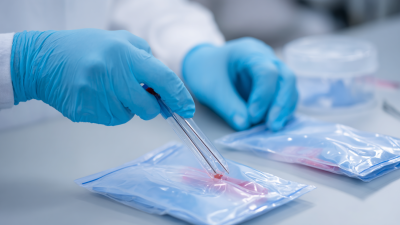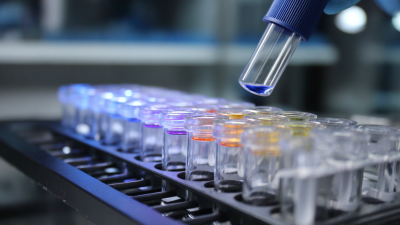 +86 178 5514 5298
+86 178 5514 5298
Leave Your Message
-
 CONTACT NUMBER
CONTACT NUMBER -
 CONTACT NUMBER
CONTACT NUMBER -
 CONTACT NUMBER
CONTACT NUMBER



In today's rapidly evolving healthcare and laboratory environments, the usage of specialized products such as 95 kPa Biohazard Bags has become increasingly critical for ensuring safety and compliance with stringent waste disposal regulations. According to a report by the Global Health & Safety Bureau, the demand for biohazard waste management solutions is projected to grow by 8% annually, highlighting the importance of effective containment methods for hazardous materials. As noted by Dr. Emily Carter, an industry expert in biomedical waste management,
"Implementing proper biohazard waste disposal is not just a regulatory requirement; it's a commitment to safeguarding public health."

The unique design and function of 95 kPa Biohazard Bags enable them to withstand the pressures and demands of diverse laboratory and clinical settings. These bags are engineered to safely contain infectious and hazardous waste, mitigating the risk of exposure to healthcare workers and the general public. A recent study revealed that institutions employing 95 kPa Biohazard Bags reported a 40% decrease in incidents related to waste contamination, underscoring their essential role in health safety protocols. This article will explore the top ten uses of 95 kPa Biohazard Bags, showcasing their versatility and effectiveness in the management of biohazardous materials.
In healthcare and laboratory settings, effective waste management is crucial for maintaining safety and preventing contamination. One of the essential tools in achieving this goal is the use of 95 kPa biohazard bags. These specialized bags are designed to securely contain potentially infectious materials, ensuring that hazardous waste is handled appropriately and reducing the risk of exposure for healthcare workers, patients, and the general public.

The importance of 95 kPa biohazard bags extends beyond mere containment. Their high strength and puncture resistance allow them to hold various types of medical waste, including sharps, contaminated linens, and biomedical waste, without fear of leaks or spills. This durability not only protects workers during the disposal process but also contributes to regulatory compliance, as improper waste management can lead to significant legal and financial repercussions for healthcare facilities.
In essence, the proper utilization of biohazard bags is a vital component of a comprehensive waste management strategy that enhances overall safety in healthcare environments.
In healthcare and laboratory settings, the use of 95 kPa biohazard bags plays a critical role in enhancing safety protocols to protect both staff and patients from contamination. These specially designed bags are engineered to safely contain hazardous materials, ensuring that biological waste is securely sealed and labeled. By utilizing such bags, healthcare facilities can significantly reduce the risk of exposure to infectious agents for their personnel, ultimately creating a safer environment for everyone involved.
Moreover, the implementation of 95 kPa biohazard bags aids in maintaining compliance with stringent regulations surrounding waste disposal. Proper disposal practices not only prevent contamination but also contribute to the overall efficiency of waste management systems. Staff members can confidently handle potentially infectious materials, knowing that these biohazard bags are designed to withstand pressures and minimize leaks. This results in a more organized approach to waste management, which is crucial in preventing outbreaks and safeguarding patient health. Such measures reinforce the commitment of healthcare providers to uphold the highest standards of safety and hygiene.
In laboratory settings, the versatility of 95 kPa biohazard bags plays a crucial role in safely handling various biological materials. As technologies advance, particularly in the realm of bio-microsystem integration, the need for reliable containment solutions has become more significant. For instance, the development of micro-total analysis systems (µTAS) and lab-on-a-chip technologies relies heavily on the secure packaging of samples to prevent contamination and ensure accurate results. This is where biohazard bags excel, offering robust protection for biological specimens during transportation and analysis.

Moreover, recent innovations in diagnostic testing, such as paper-based assays, have expanded the scope of materials that can be efficiently managed using biohazard bags. These bags facilitate the safe disposal and storage of waste generated from tests that are becoming increasingly versatile, such as rapid COVID-19 diagnostics. As researchers explore new biomaterials, like the transparent mycelial film derived from fungi, biohazard bags remain vital in managing these biological innovations, ensuring that all materials are handled with the utmost care and compliance with safety standards.
Biohazard bags, especially those rated at 95 kPa, play a critical role in healthcare and laboratory settings, ensuring compliance with health and safety regulations. According to the U.S. Environmental Protection Agency (EPA), proper containment of biohazardous materials is essential to mitigate risks associated with infectious waste. These bags not only protect against leaks but also meet the stringent requirements set forth by organizations such as the Centers for Disease Control and Prevention (CDC) and the Occupational Safety and Health Administration (OSHA). Using sturdy, compliant biohazard bags minimizes the likelihood of exposure to harmful pathogens, thus safeguarding both healthcare professionals and patients.
Tip: Always check for certification labels on biohazard bags to confirm they meet the required standards for your specific applications. It’s also advisable to train staff in proper waste segregation and disposal techniques, as this can significantly reduce the risk of breaches in safety protocols.
In addition to regulatory compliance, implementing best practices for the management of biohazard bags can enhance safety in medical facilities and laboratories. Recent studies indicate that facilities that adhere to strict biohazard waste management procedures experience a 30% reduction in workplace contamination incidents. This highlights the importance of not only using high-quality bags but also maintaining a culture of safety through employee education and regular audits of waste management processes.
Tip: Schedule periodic training sessions for all staff members to keep everyone informed about the latest regulations and best practices in biohazard waste disposal.
In healthcare and laboratory settings, the proper management of biohazard waste is crucial for maintaining safety and compliance. Educational and training applications focused on biohazard disposal can significantly raise awareness among medical staff, laboratory technicians, and even students. Conducting workshops and seminars about the correct usage of 95 kPa biohazard bags ensures that personnel understand the importance of proper waste segregation, which directly impacts overall safety in these environments.
To enhance training sessions, consider incorporating interactive elements such as quizzes or hands-on demonstrations. This not only engages participants but also reinforces their understanding of biohazard protocols. Displaying visuals or infographics about the risks associated with improper disposal can further solidify the message.
Additionally, encourage regular refresher courses to keep staff updated on any changing regulations or best practices related to biohazard disposal. Remind everyone that using the correct biohazard bags is not just a matter of protocol; it's a vital responsibility for maintaining a safe and compliant workplace.






